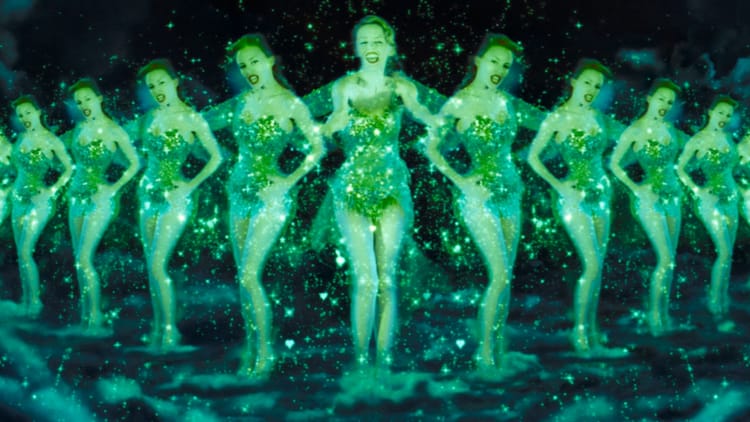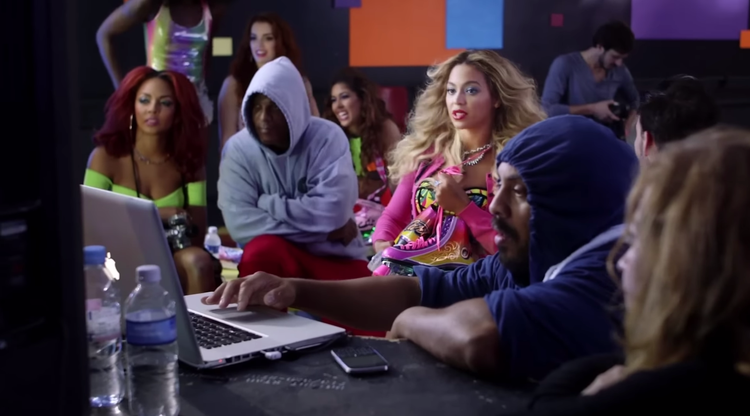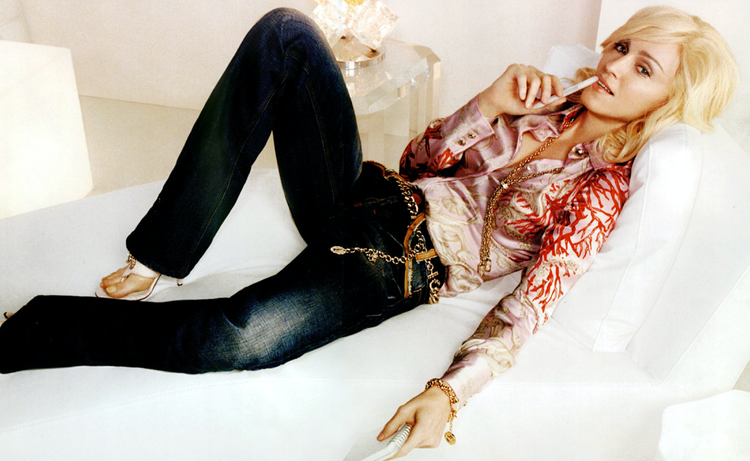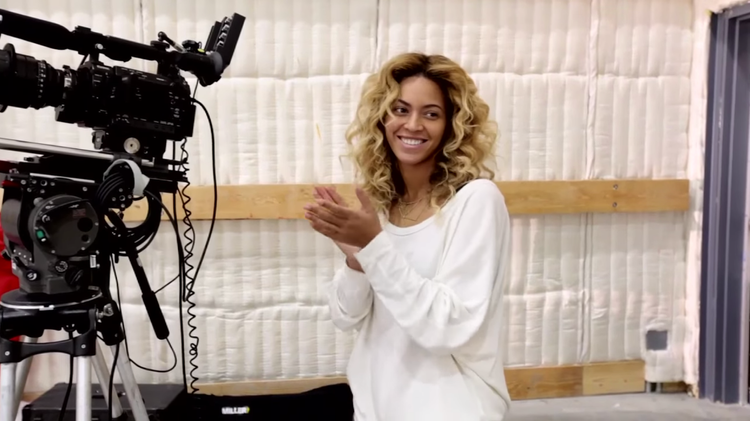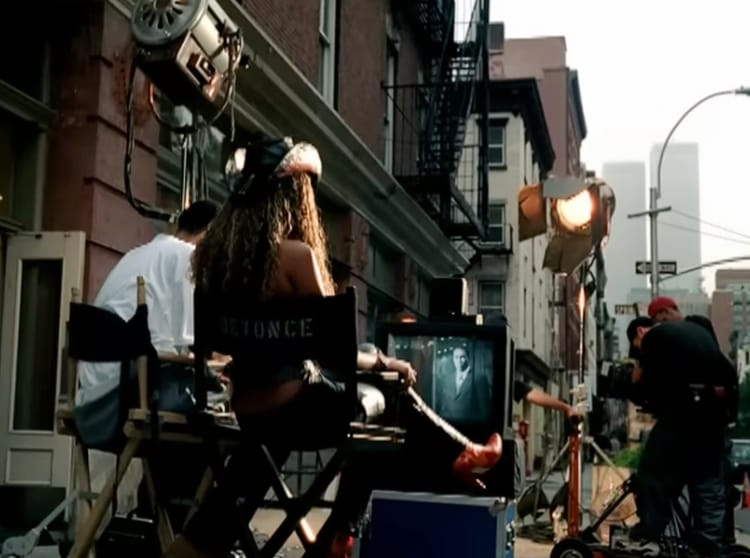"My Biggest Enemy Is Me"
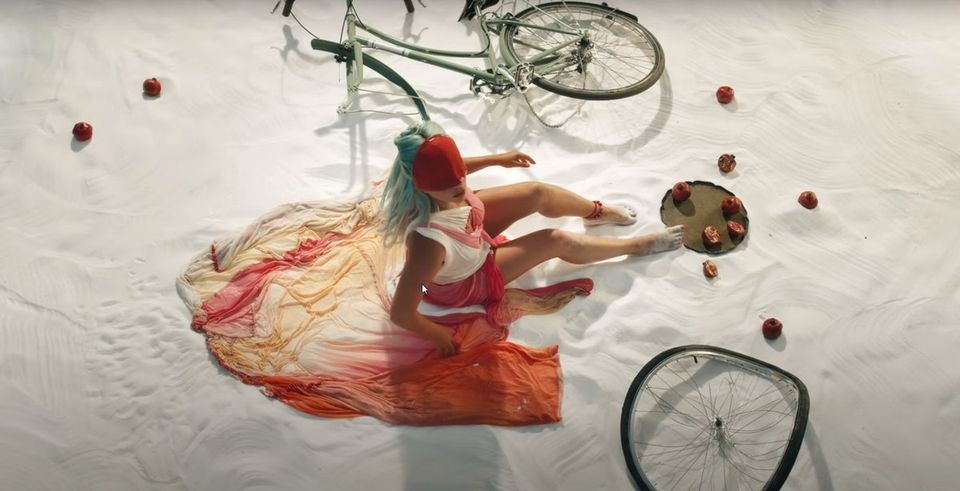
I’m not really supposed to be writing anything right now, and frankly didn’t think I’d be able to until at least a decade had passed since handing in my thesis. But as someone who writes a newsletter about how pop music artists use their visuals to self-mythologize—that sounds so prohibitively specific, yet here we both are—my two favourite Italian-American divas have compromised both my willpower and writer’s block this month. First came the announcement that Madonna has plans to self-direct her biopic, something I kind of figured was going to happen. Then came Tarsem Singh’s video for Lady Gaga’s “911,” my favourite song from Chromatica (2020). (You’ll want to have seen it before reading the rest of this.)
Madonna and Lady Gaga have always been spiritually linked in my head, but not exactly for the same reasons as they are for other people. There are definitely artistic similarities between them, but I’ve always found their so-called feud uninteresting, for reasons I can get into at a later point in time. A lot more compelling to me is how much the two women share biographically. Both are eldest daughters and natural brunettes who were raised Catholic and forged in New York City. Both danced to pay the bills until they found their breaks in the music industry. Both dropped out of well-regarded universities relatively early in their programs to do this: Madonna had been at the University of Michigan on a dance scholarship, and Gaga had been studying music at New York University. Both have left a trail of failed engagements and/or marriages in the years since. Both currently live with some form of chronic pain. And both are survivors of sexual assault—which, heads up, is something I’ll be talking about on and off for the rest of this essay.
In Madonna’s first year in New York, which she’s described as being challenging for a number of reasons, she found herself locked out of a dance class one day, and asked a man on the street for payphone money. He offered up his own phone, since he said he lived just across the street. She accepted the offer because she “trusted everyone,” as she told Howard Stern in 2015. The man ended up raping her on the roof of the building at knifepoint. She thought that reporting the assault seemed “too humiliating,” and didn’t reveal it publicly until 1995, so almost two decades later.
Before 1995, sexual assault had appeared in Madonna’s work a handful of times, but never in an autobiographical sense. The “Like a Prayer” (1989) video had involved a woman being attacked by a group of white men, with a Black man arrested for the crime. At one point in the documentary Madonna: Truth or Dare (1991), her makeup artist, Sharon, believes that she was assaulted the night prior. A crew member fills Madonna in. “I don’t believe that you don’t remember things like that. How could Sharon not know what happened to her?” Madonna asks, and is told that Sharon was likely drugged. At this, Madonna laughs nervously, then apologizes for laughing; it’s an uncomfortable and rightly criticized moment in the film. The next year, she released Sex (1992), a coffee table book of erotic photographs by Steven Klein, where more than one image indicated a struggle on her part. In hindsight, these examples pointed to a woman who didn’t really know what to do with, or make of, her own assault. But because that assault wasn’t yet public knowledge, any missteps or provocative art came off as needlessly cruel or inappropriate, rather than the behaviour of someone who’d built her entire persona on indestructibility and sexual empowerment but who’d secretly experienced sexual violence. Her victim blaming in Truth or Dare may have been an inability to extend another survivor the sort of compassion that she’d not yet found for herself. (Her public comments regarding her own assault are full of self-blame.) Which is not to excuse her nervous laughter, but maybe contextualize it a bit.
I was reminded of Madonna’s experience with sexual assault this month because the worst of tabloid media has responded to her biopic announcement by declaring that the film will “recount the horrifying moment,” according to an unnamed source who, in all likelihood, doesn’t actually exist. There’s an obvious (and gross) desire for clicks here, but these reports have nevertheless factored into my thinking so far about what the film might end up looking like.
When I saw the announcement, my brain drew a pros and cons t-chart and started filling it in. As a film critic, I know that artists being creatively involved in the telling of their own life stories can be bad from an objectivity point of view. Last year, I reviewed The Dirt (2019), a Mötley Crüe-produced film about Mötley Crüe that I didn’t love. I appear to have written that it and Bohemian Rhapsody (2018) are “excellent examples of how artists’ involvement in their own biopics usually results in sanitized, overly filtered versions of the past.” This wasn’t a compliment in the context of my review, but you’ll know if you regularly read this newsletter (or my work, more generally) that I don’t discard projects by default of them having revised or sanitized history. I’m more interested in what exactly has been revised or sanitized, and the impact of those revisions on an artist’s public image. It also matters whether a project had any claims to truth in the first place. In the context of The Dirt, which Netflix marketed as “unflinching and uncensored,” producer Tommy Lee had made sure that the on-screen version of his relationship with Pamela Anderson didn’t involve him abusing her. (He served actual jail-time for this.) There are the kinds of relatively harmless omissions that I discussed a few newsletters ago in the context of pop diva documentaries, and then there’s this kind of omission, which I don’t think artists should get to make.
So, what exactly is Madonna’s track record with respect to revising history? There are aspects of her life that she’s been tight-lipped or ambiguous about for decades; the true nature of her marriage to Sean Penn is a good example. But there are also signs that she isn’t as prone to the same sort of sanitizing as Tommy Lee. For one, her brand isn’t as tightly controlled as those of, say, Beyoncé or Taylor Swift, who spend their lives in hiding unless there’s a specific reason to come out of hiding, after which they go right back into hiding. Madonna is instead the sort of artist who’d host a 65-minute Instagram Live session, as she did the other day with biopic co-writer Diablo Cody, so that fans could watch them work and ask Madonna questions. The session was raw and sometimes awkward in a way that confirms Madonna’s chillness with the raw and the sometimes awkward. (As a maybe useful point of comparison, when Beyoncé answered fan questions in 2013, those questions had been carefully chosen ahead of time.) Madonna has also chatted pretty openly about the less triumphant and even traumatic parts of her story, from the death of her mother, to the eras that didn’t go over as well as she’d hoped, to her divorces. We can add her assault to this list. The film is really an opportunity for her to recount these events on her own terms, but with Cody there doubling as a sort of watchdog.
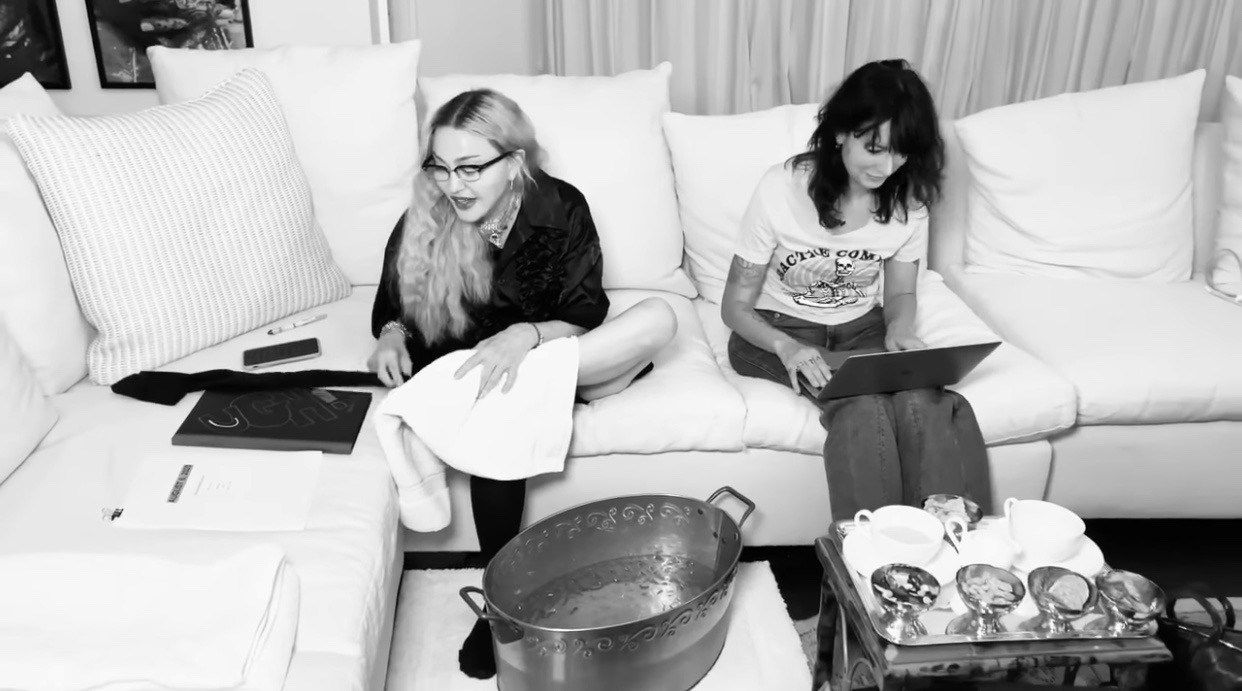
Three days after the biopic announcement came a completely different example of an artist approaching their own biography. Lady Gaga released the video for “911,” her third (and, in my opinion, best) of the year. “[The song is] about an antipsychotic that I take,” she told Zane Lowe in May. “And it’s because I can’t always control things that my brain does. […] And I have to take medication to stop the process that occurs.” This is probably more or less what she told filmmaker Tarsem Singh, with whom she wanted to collaborate on the video (and who’d reportedly never heard a Lady Gaga song before). In an interview with Entertainment Weekly, Singh said that he had a 28-year-old unused concept that revolved around someone seeing “abstractions” because they’re losing blood after an injury, then finding out that they were abstractions—“basically The Wizard of Oz without the first act.” “When [Gaga] told me [what the song] means, [the concept] fit like a glove,” he said. “I made it not about blood loss, but about the opposite of being high on drugs: Basically, a lack of a drug.” In the video, Gaga’s character sees abstractions that look a lot like Sergei Parajanov’s The Color of Pomegranates (1968). We learn in the last minute of the video that she’s been in a road accident, and that her brain was abstracting details from the collision scene, including a nearby poster for Pomegranates. “I didn’t have my pills,” she tearfully tells a paramedic.
In 2014, while defending a controversial performance of the song “Swine” from ARTPOP (2013), Gaga revealed to Howard Stern that she’d been raped at 19 by an unnamed music producer who was 20 years her senior. (She’s since clarified that this happened “repeatedly for months,” but, unlike Madonna, has made a point of keeping most of the details to herself otherwise.) Gaga’s ARTPOP era, a self-described “dark time in [her] life,” was full of art that she’d later call “extremely defiant and provocative because [she] was angry and still hadn’t processed the trauma that had occurred.” Once she did begin processing it, her art started to evince more self-compassion. There was co-writing “Til It Happens to You” with Diane Warren for The Hunting Ground (2015), and performing the song at the Oscars alongside dozens of sexual assault survivors. There were offhand lyrical allusions to the assault, as in “Diamond Heart” from Joanne (2016): “Some asshole broke me in / Wrecked all my innocence.” And, most recently, there was Chromatica, an album all about trauma and healing.
Before any of this happened, however, Gaga at one point experienced a psychotic break. “My whole body started tingling and I started screaming,” she recalled to Oprah Winfrey earlier this year. “I was in a hospital. It’s very difficult to describe what it feels like other than that you first start to tingle from head to toe and then you go numb. The brain goes, ‘That’s enough. I don’t want to think about this anymore. I don’t want to feel this anymore.’ Boom. You break from reality as you know it.” Gaga has been on anti-psychotics since then. “I didn’t realize how close the idea was to what happened to her,” Singh explained of his “911” concept. “I told her the idea [over Zoom], and by the end she said there can be no other idea, this is the idea. I got up and started bumping the air and jumping around, and I looked back and she was crying. I was like, fuck, this is a lot more personal to her than I realized.”
Watching the “911” video, I was reminded a little of “Marry the Night,” a self-directed video from Born This Way (2011) that very loosely tells the story of Gaga signing with Interscope Records. It’s worth a watch (or re-watch) once you know about her psychotic break and her time in the hospital. It begins with a voiceover from Gaga:
When I look back on my life it’s not that I don’t want to see things exactly as they happened, it’s just that I prefer to remember them in an artistic way. And truthfully the lie of it all is much more honest because I invented it. Clinical psychology tells us arguably that trauma is the ultimate killer. Memories are not recycled like atoms and particles in quantum physics. They can be lost forever. It’s sort of like my past is an unfinished painting and as the artist of that painting I must fill in all the ugly holes, and make it beautiful again. It’s not that I have been dishonest; it’s just that I loathe reality.
This is a compelling statement to revisit in light of the “911” video, and it’s also aligned with what Madonna has said of her own loosely autobiographical projects: “People don’t see that you can take some of your experiences from real life and use part of them in your art. They try to make everything an absolute truth.” Her biopic is obviously a different story, and I’ll be paying close attention to the language that she uses to talk about it, especially since she’s posting constantly (or what feels like constantly, at least) on social media these days. “Nobody knows what I know and what I have seen,” she posted on Instagram in 2017, presumably in response to news that Universal was developing an unauthorized biopic about her. “Only I can tell my story.” As for how much poetic license she ends up using to tell that story, we’ll have to wait and see. Madonna’s biggest enemy here is Madonna. ●
Mononym Mythology is a newsletter about mostly pop divas and their (visual) antics. It’s totally free, but if you got something out of this instalment, consider buying me a coffee. The best way to support my work otherwise is by sharing it. You can subscribe here, and you can also find me on Twitter and Instagram.
